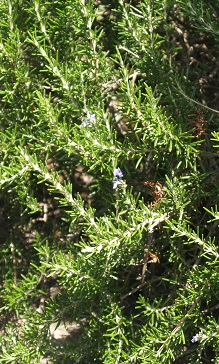Growing Rosemary
 Rosemary (Rosmarinus officinalis) is a very popular herb. A woody shrub to 1.2 m, with grey-green needle-like foliage, with small pale-blue flowers.
Rosemary (Rosmarinus officinalis) is a very popular herb. A woody shrub to 1.2 m, with grey-green needle-like foliage, with small pale-blue flowers.
Growing Conditions:
Best in full sun. Grows in most climates, but prefers temperate areas. Tolerates very cold temperatures and heavy frosts, but may not tolerate excessive heat.
Culture:
Prefers fertile, well drained, slightly alkaline soils, although it is tolerant of poorer soils. Avoid using fresh manures. Do not over water and ensure that drainage is very good. Mulching may be beneficial to control weed competition. Prune back after flowering and to maintain shape.
Companion Planting:
Companion plant with cabbage, beans and carrots. Do not plant near potatoes. Repels sap-sucking insects
Propagation:
Easily, but sometimes slowly by cuttings. Semi-hardwood cuttings are best. Can also be propagated from seeds or layering
Pests and Diseases:
Few. Sometimes affected by root rots, wilt, mites and some leaf-eating insects.
Uses:
Used as a bath herb, and as a dye. An infusion of the leaves may be drunk for alertness. Leaves are used fresh or dried in cooking (e.g. meats and vegetables), in herb butters, vinegars and jams. The extracted oil is used in perfumes. Both flowers and foliage can be used in pot pourri. Useful as a low to medium hedge. Prostrate variety is a useful ground cover.
You may also be interested in....